ROBESON COUNTY
TOWNSHIPS
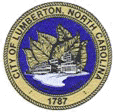
Lumberton
North Carolina
The original town of Lumberton began prior to the Revolutionary War as a settlement on the 250-acre plantation owned by General John Willis. Known as the founder of Lumberton, Willis in 1787 petitioned the state legislature for a charter granting the town status as the county seat of the newly formed Robeson County. The town's original lots were sold in 1787 and a building owned by Willis was deeded to the county to be used as a courthouse. Willis went on to represent Robeson County in both the State Senate and state convention that approved the Federal Constitution in 1789.
A 1794 law called for the governance of the town by five directors with power of taxation. Unobligated tax money was designed to support Lumberton Academy which also served as a church. This academy was first chartered in 1793 and re-chartered at three other times.
According to local historians, the main stage coaches from Elizabethtown and Fayetteville met at Lumberton to use the toll bridge across Drowning Creek (Lumber River). The river's high bluff was the launching point for thousands of logs floated down the river to Georgetown. Thus, Lumberton has been a center of economic development for over 210 years.
In the latter half of the 19th century, railroads replaced waterways and wagon roads as the main source of transporting local agriculture and timber products. The Wilmington to Lumberton line was completed in 1860.
An 1884 publication notes the town, "one of the prettiest in the state," with a population of 1200, twenty stores, five churches, saw mills, turpentine distilleries, and four hotels. Land could be purchased for as little as $5 per acre.
The turn of the century saw continued railroad expansion and growth in the tobacco and textile industries. Electric lights replaced kerosene street lamps in 1904. The public library was organized in 1924. The population grew to 4100 by 1930.
In 1945 the city of Lumberton was chartered by the North Carolina General Assembly. In recent years, its residents have been active in refurbishing the historic area and guiding its new industrial growth. Lumberton was among the finalists for designation as an All-American City in 1995. Home today to a diversified array of internationally owned companies, Lumberton takes pride in its contributions to the cultural and economic history of this area.
Please visit our town website at: www.ci.lumberton.nc.us.

Pembroke
North Carolina
Settled in 1789 and incorporated in in 1895, the town site of Pembroke was first called Campbell's Mills. The town developed around businesses that served the Lumbee Indian population that resided in this area prior to the American Revolution. Earlier known as Scuffletown, the town's name derives from a principle stockholder in the Atlantic Coastline Railroad, Pembroke Jones. The town's corporate limits as surveyed and mapped, were based on the intersection of two railway lines.
Under an 1885 law, twelve school districts were established providing elementary education for Lumbees. In 1887 a state-funded school, the Croatan Normal School, was begun with minimal funding to train teachers for the newly established schools.
By 1928 the school offered high school and normal school courses and in 1940 awarded its first four-year degrees. In 1941 the name of the school was changed to Pembroke State College for Indians and shortened to Pembroke State College, in 1949. University status was granted in 1969 and the University of North Carolina at Pembroke became part of the 16 campus state university system, in 1972.
Contributions to Pembroke have long been associated with the cultural and political history of the Lumbees. Pembroke University houses the Indian Cultural Center that has engaged in research and preservation of the Native American culture of this area. Visit the Pembroke Chamber of Commerce website at www.pembrokechamber.com
Please visit our town website at: www.pembrokenc.com.
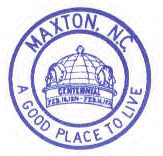
Maxton
North Carolina
The first settlers in this area settled along the Shoe Hill Creek and Lumber River in the late 1700s. Incorporated in 1874 as Shoe Hill (from the Gaelic "S", the shape of the nearby creek), Maxton also held the names of Tilden (after an 1876 Democratic candidate for US President) and Quhele (Gaelic for "narrow part of a stream"). The name was changed back to Shoe Hill in 1881 and finally to Maxton in 1887. Maxton was chosen to honor the Scottish settlers to the area.
Floral College was founded in 1841 by John Gilchrist, Jr. and was closed in 1878. It was the first woman's college in the State to confer degrees. The remaining building of the college has been moved to the grounds of Centre Presbyterian Church.
Maxtonians of Note:
Birthplace of Angus W. McLean, Governor of North Carolina, 1924-1928. He went on to serve in the US Senate until his death in 1935.
Malcom McLean, founder of McLean Trucking and SeaLand Inc. He was named "Man of the Century" by the International Maritime Hall of Fame.
Alice Russell Micheaux, concert soloist and movie actress - her credits include: The Betrayal (1948), God's Step Children (1938), Murder in Harlem (1935) and The Broken Violin (1927).
Town facilities include Gilbert Patterson Memorial Public Library and Maxton Family Resources Center. The Maxton Historical Society operates a museum of local history, which is open on Sunday afternoons.
In the past few years the Town has begun to revive itself.
Please visit our Town website at: www.maxtonnc.org.
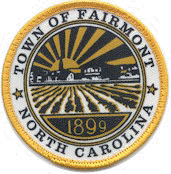
Fairmont
North Carolina
First settled before the American Revolution by Islam Pittman from South Carolina, Ashpole, Fairmont’s original name, was attributed to the abundance of ash trees in the nearby swamp. Its early economy was influenced by the lumber resources and later, railroad expansion. The church was a strong influence in the area with the Ashpole Presbyterian Church established in 1791. Prior to the that, the church building had served as a school and meeting house for all denominations until 1787 when the Methodists organized their own church. Ashpole Institute was founded here by Rev. Stinson Ivey in the 19th century.
Ashpole became a stop on the Southeastern Railroad line in 1898 and the town’s first lots were sold. Incorporated as Union City in 1899 as a meeting point for the railroad and the tobacco market, the town did not retain this name. It was instead renamed Ashpole until 1907 when the current town name, Fairmont, was adopted.
Commercial growth of the town expanded in this century. One general store and a blacksmith shop were noted in 1879. By 1930 thirty general stores and a variety of other enterprises had been established.
Fairmont’s 20th century growth has been associated with the tobacco industry. Today, truck farming and the textile industry are expanding as part of the economic development of this area.
Fairmont has several medical facilities, specializing in general medical and dialysis.
Come and play golf at the Flag Tree of Fairmont Golf Club, www.flagtreegolf.com, an 18 hole championship course in excellent condition, located on HWY 130 By-Pass.
Please visit our town website at: www.fairmontnc.com.
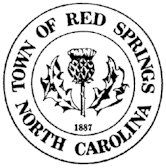
Red Springs
North Carolina
Steeped in traditions traced from the Scottish Highlanders, Red Springs was founded in 1775 by Sailor Hector McNeill on a tract granted by King George III and signed by the North Carolina colonial governor, Josiah Martin. The town's name originated from the red pigment found in the local mineral springs. The medicinal value of the springs made Red Springs a center of population both as a health resort and a hub for agricultural, industrial, and educational activities. In 1852 Malcolm McNeill, the grandson of Sailor Hector, built a hotel which was replaced by the Townsend Hotel in 1891. The Lumber Bridge military company took part in the festive July 4th opening of McNeill's Hotel.
Incorporated in 1887, Red Springs has long been associated with education. In 1852 a frame school building was built near the hotel. For nearly 40 years it was the site of religious meetings, dances, and school. The North Carolina Military Academy opened in 1899 and attracted male students until 1908.
In 1896 Red Springs Seminary opened as a female seminary. It was renamed Flora MacDonald College in 1914 to honor the Scottish heroine who had helped Bonnie Prince Charlie escape the Stuart uprising in Scotland. Today the building, listed in the National Register of Historic Places, houses Flora MacDonald Academy, as K-12 college preparatory private school.
The annual Flora MacDonald Highland Games and Gathering of Clans is held in October. Dancing, pipe band competition, and traditional games attract many visitors to the two day event.
Cotton, soybean, tobacco, and lumber production have long been associated with the economic progress of this community. Textiles and agribusiness form a sold foundation for industrial expansion.
Please visit our town website at: www.redsprings.org.
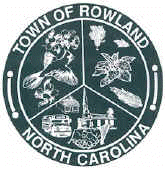
Rowland
North Carolina
The railroad contributed to the establishment of Rowland. When the railway was extended to this area from Florence, SC in 1888, the people from Plainview established Rowland, naming it for Colonel Alfred Rowland, a Confederate officer. Its first general store was owned by R. S. Bond. A post office opened in 1888 and the town was incorporated in 1889.
The railway depot, built in 1890 and remodeled in 1925, now houses the McMurray-McKeller Museum that includes period furnishings and displays of railroad and other historic memorabilia.
Nearby historic sites include the Ashpole Presbyterian Church, organized in 1796, Providence A.M.E. Zion Methodist Church founded in 1885, and the grave site of Robert Adair, a famous early resident. Dr. Adair, author, soldier, and explorer, wrote History of American Indians, published in 1775.
From its population of 72 in 1890, the town grew to 999 in 1940 and adopted the motto, "The town of a thousand friends". It was home to the county's first public library, established in 1903 by local residents each donating one book to its collection, housed in the office of the local dentist, Dr. C. H. Lennon.
Known as a farming community amid rich, productive farmland, Rowland's residents take pride in the agricultural heritage.
Please visit our town website at: www.townofrowland.org.

St. Pauls
North Carolina
St. Pauls dates back to 1799 when the St. Pauls Presbyterian Church was built on land donated by William Davis. During the early 1800's only four buildings comprised the town: the church, the post office, a livery stable, and Davis' home. The first community and businesses grew up around the sixteen-mile post on the stage road from Fayetteville to Lumberton, where coaches changed horses at Davis' livery stable.
The town's growth resulted in the establishment of an academy, Robeson Institute, in 1845. A 1925 paper reports that "It was a mixed school (gender), but was taught by competent teachers." In 1885 the academy burned and was never rebuilt. A new school, combined with the Masonic Lodge, was built in 1886.
The textile industry flourished during the early part of this century with the building of three cotton mills by 1920. The worldwide depression of the 30's contributed to the selling of the mills in 1943 to Burlington Mills Corporation. The textile industry continues to be a leading contributor to the area's economy.
The railroad industry contributed much to the history of St. Pauls. The Virginia and Carolina Railroad, connecting St. Pauls with Lumberton and Elizabethtown and branching with the Atlantic Coast Line at Hope Mills, was built 1907-1910 by the Atlantic Improvement Company. This influenced the surveying and sale of home lots and establishment of the business section next to the railway station.
The town was incorporated in 1909, the same year of the town's first telephone line. An electric light line came to St. Pauls in 1912. Both of these local companies were bought in the 1920's by companies offering statewide service.
In 1923, St. Pauls was described as a "rosebud of nature's beauty "with its three cotton mills, flour mill, bank, newspaper, lumber company, ice company, three doctors, and three lawyers and "nice wide streets with plans to pave".
Today, the area surrounding St. Pauls is known for its diversified farming and improving economic base.
Please visit our town website at: www.stpaulsnc.gov.

Lumber Bridge
North Carolina
Incorporated by the General Assembly in 1891, Lumber Bridge residents take pride in its cultural and civic history. Believed to date from 1776, the original land grant was part of the holdings of Levey Glass. The town's name comes from the hand-hewn bridge over the Little Marsh Swamp.
The Lumber Bridge Light Infantry Company, today housed in Parkton, was first chartered in 1547 and remains the oldest North Carolina military company and the second oldest guard in the nation still in active service. Known since the Civil War as the "Scotch Tigers" to honor the fore bearers of this area, the unit has also served in the Spanish-American War and World Wars I and II. Many present guard members are Vietnam and Desert-Storm Veterans. The "Scotch Tigers" National Guard has frequently assisted storm victims, most recently being deployed in response to Hurricane Fran.
The town was also home to the first eastern North Carolina high school which was accredited in 1907. Known for its strong college preparatory program, the school was phased out in 1931 due to a declining town population.
The May 20, 1909 Robesonian highlights the importance of truck farming of vegetables and cotton to this area.
Lumber Bride experienced a loss of jobs and labor force that faced many communities during the depression and war years of the 1930's and 40's. However, an upbeat climate is evidenced today by the new industries that have located here.
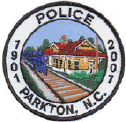
Parkton
North Carolina
Parkton was settled about 1884 and named Piney Forest. A one-room schoolhouse, Piney Forest Academy, was renamed Parkton Institute in 1891. The name Parkton may originate from the name of a railroad engineer who mapped the area adjacent to the first tracks. Another theory is that the town was named for the nearby parking area used by the railroad travelers. The depot, originally on the west side of the tracks, has been preserved by the Parkton Historical Society, through an arrangement with the Atlantic Coastline Railroad. Ten daily trains stopped in Parkton in the years preceding the use of the automobile for mass transportation. Incorporated in 1901, Parkton boasted only one general store at that time, McMillan and Hughes.
